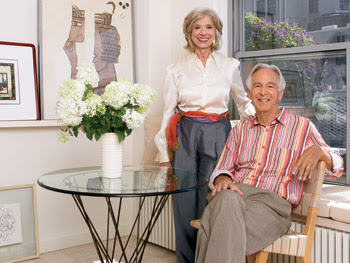Article taken off oprah.com
The Joys of Letting Go

The Solomons began one night 38 years ago when Angela, who was living in a "no-bedroom" in Greenwich Village, reluctantly agreed to go on a blind date with a young doctor who had just finished studying in Switzerland. "I was so not into settling down," says 70-year-old Angela, now a communications consultant for television and film clients. "It was the '60s."
The two were married on May 3, 1969—a date they're reminded of by a signed '69 Spoleto Festival poster, a wedding gift from a friend, on display in their living room. All the art in their home is the work of people close to them—everything from photos taken in Japan, India, and Paris to groupings from a school of ceramics Joel simply calls "friend pottery." The couple doesn't have children, but pictures of young relatives are everywhere. "What we wanted to hang on to in our new home is what downtown New York represents for us—it's all about our friends," Angela says. "Other than that, we wanted to cut and run!"

Of course, you can make a clean break with your fireplace tools (and heavy Persian rugs, elaborate draperies, hulking dining-room table, gilt-edged mirrors) and still have to figure out where to put everything you're leaving behind. "We had 30 years in 4,000 square feet," Joel says. "That's 120,000 square feet of stuff over the years. We clearly needed a decorator and a therapist." The couple found both in Robert Levithan.
An acquaintance of the Solomons, Robert is a counselor who works with Friends in Deed, a crisis center for people dealing with life-threatening illnesses. When Angela and Joel learned that he also consulted on the design of friends' homes, they signed him on to help with their transition.
"Moving is high up on the life stress list, which includes things like the loss of a loved one or divorce," Robert says. A thorough, compassionate listener by profession, he came up with a design plan for his clients that was part talking cure ("There were absolutely daily conversations"), part triage.

Joel estimates that in the end, half of his and Angela's belongings were given away or sold. About a quarter went to his new office and the rest fit into the clean grid and airy, serene aesthetic Robert created for the Solomons' new home. "It's as clear and light as possible," Angela says. "There's a see-through, floaty theme, which is great for small spaces. Everything has very thin legs. Everything but me," she adds, laughing. "I don't have thin legs."

In their new downtown lives, Angela says that she and Joel "walk almost everywhere." The two also enjoy a luxury they didn't have uptown—outdoor space, in the form of a terrace overlooking Washington Square Park and one of the city's last charming mews. "They are lively," Angela says of the New York University students in the storied park, "and the view will always be here."
She's true to Robert's mantra for moving with a good mind-set. "Focus on where you're going and what you're creating, not on what you're leaving behind," he says. "It's not about less; it's about different. And once you get there, everything shifts in your life, often in marvelous ways."

Angela considers her new, trim, skinny-legged dining table and says that she and Joel used to host a Thanksgiving feast for more than 30 people on the Upper West Side every year. Now they prefer to be in India, or Paris, or Indonesia. "We tend not to be in the city on holidays anymore. Place cards and the whole thing are no longer necessary," she says with relief. "Living downtown again hasn't really reinvented our lives, but having time at our discretion—and a home that fits our new lives—has. It's very freeing."

Before moving to a new home, consider Robert Levithan's strategies for relocating with the right mind-set.
• Do It Quickly: There's no point in drawing out the process or dwelling on where you used to live, mentally or physically. "You need to get where you're going," Robert says. "As soon as you're in the new place, it's very easy. You've shifted from the loss process to the creation process."
• Be Practical, Not Sentimental: If your move is about downsizing, Robert recommends that you start by identifying the objects that will go with you and those that can be left behind. If there's an item you're not quite ready to part with, consider storage. Better yet, he says, "Give it to someone you love or to a charity. You can also pass something down as an heirloom now, rather than waiting until you die."
• Entertain: "It's a good idea to surround yourself with a support system," Robert says. Include friends and family at various stages of the process—invite them over, pick up some wine, and have a box-packing party. "Then the move becomes a social rather than an awful, desperate thing. Make it a transition that includes the people in your life."